A Case Study: Competitiveness of McDonald's and Hungry Jack in Sydney
VerifiedAdded on 2021/12/28
|18
|3443
|43
Report
AI Summary
This report presents a comparative analysis of McDonald's and Hungry Jack, two leading fast-food chains in Australia, with a specific focus on the Sydney market. The study begins with an industry analysis, examining market structure, including the degree of standardization and concentration, and employing Porter's Five Forces to assess competitiveness. It then delves into the growth strategies of both companies, based on primary research from interviews with managers and employees, revealing insights into their cost leadership, product differentiation, market penetration, and product development strategies. Finally, the report explores the pricing and non-pricing strategies of McDonald's and Hungry Jack, highlighting the use of price bundling and psychological pricing by McDonald's, and cost-effective and market-based pricing by Hungry Jack, drawing on both primary and secondary research. The report concludes with a comprehensive overview of the competitive dynamics within the Australian fast-food industry, emphasizing the evolving consumer preferences and the strategic approaches adopted by McDonald's and Hungry Jack to maintain their market positions.
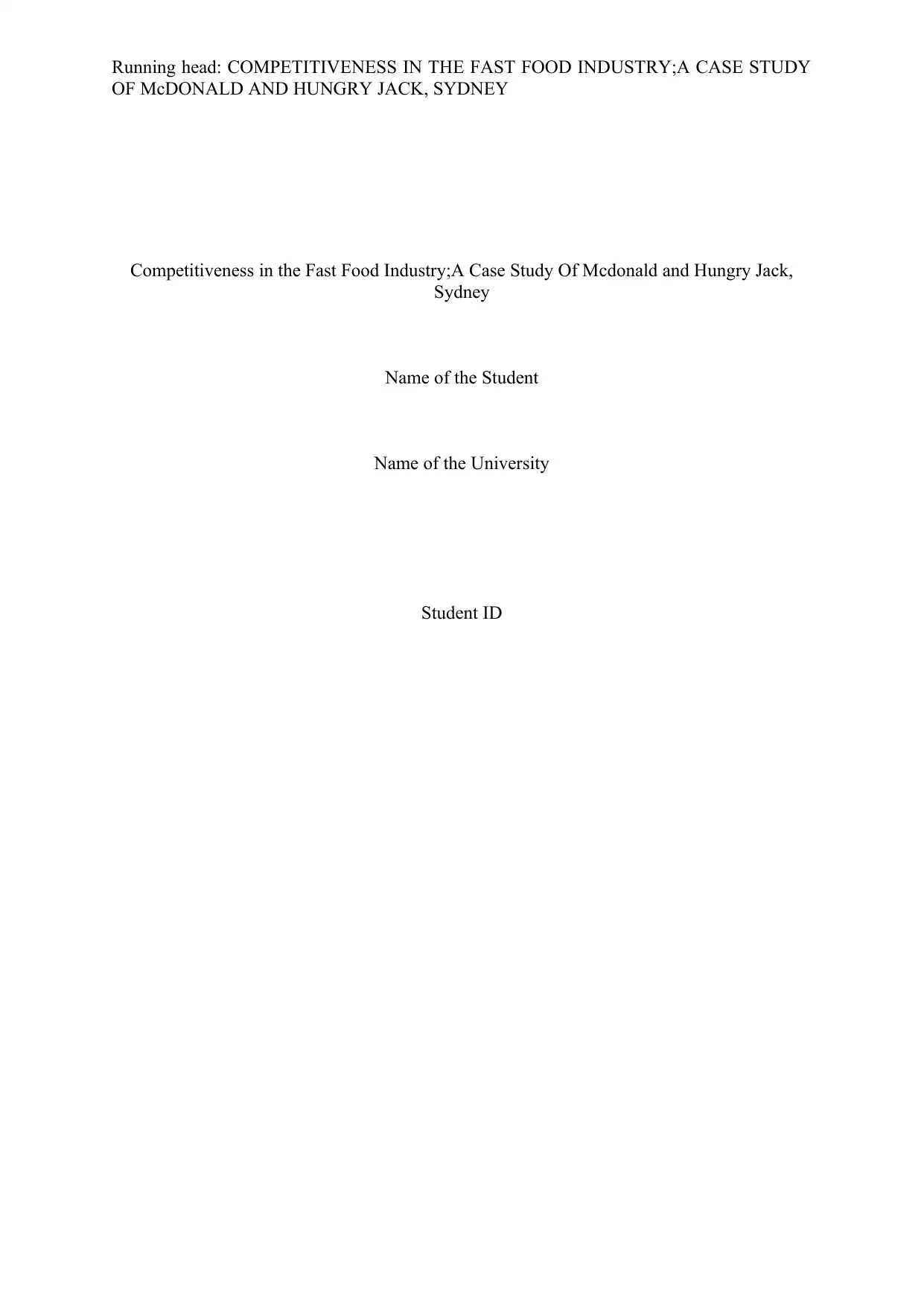
Running head: COMPETITIVENESS IN THE FAST FOOD INDUSTRY;A CASE STUDY
OF McDONALD AND HUNGRY JACK, SYDNEY
Competitiveness in the Fast Food Industry;A Case Study Of Mcdonald and Hungry Jack,
Sydney
Name of the Student
Name of the University
Student ID
OF McDONALD AND HUNGRY JACK, SYDNEY
Competitiveness in the Fast Food Industry;A Case Study Of Mcdonald and Hungry Jack,
Sydney
Name of the Student
Name of the University
Student ID
Paraphrase This Document
Need a fresh take? Get an instant paraphrase of this document with our AI Paraphraser
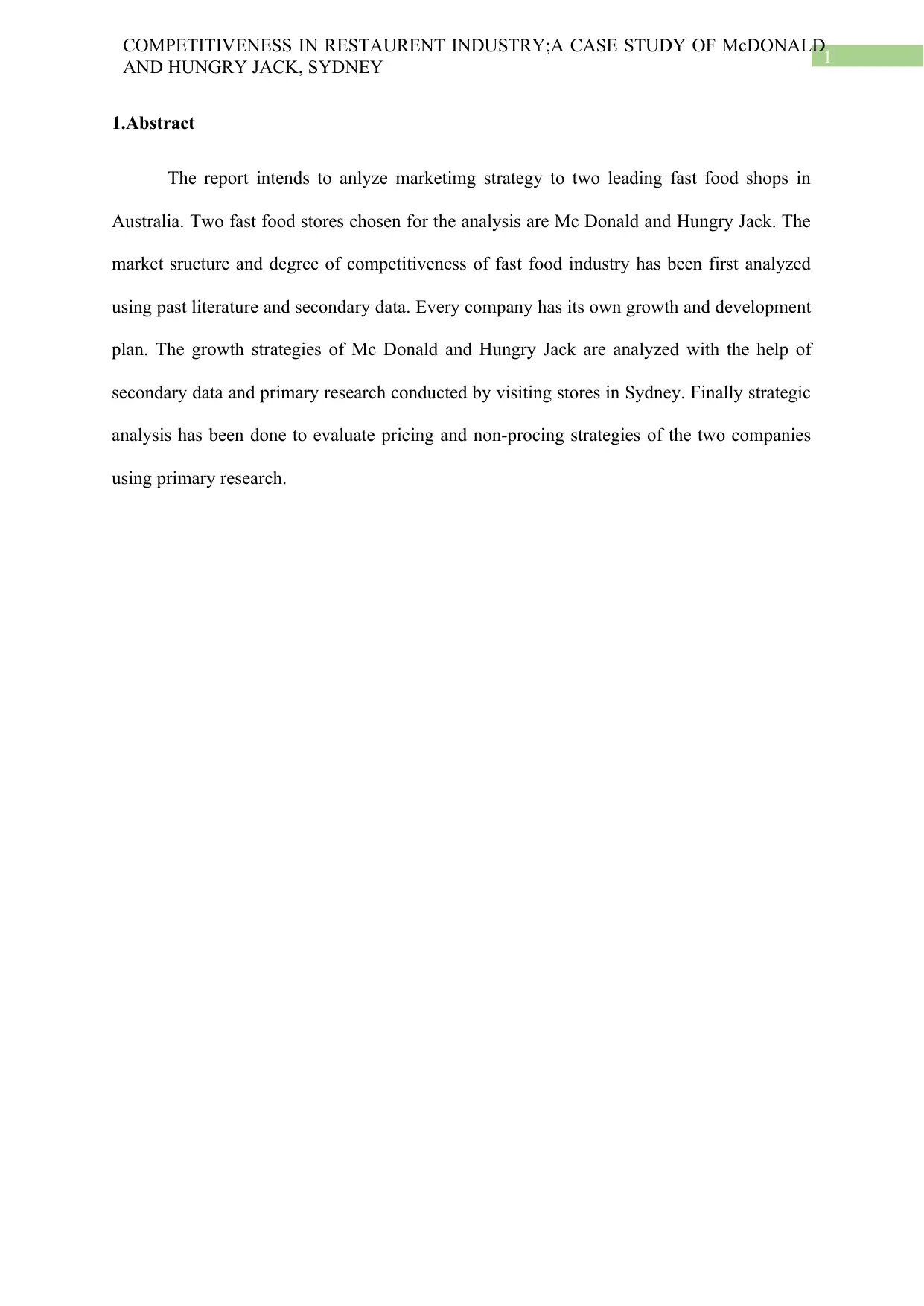
1
COMPETITIVENESS IN RESTAURENT INDUSTRY;A CASE STUDY OF McDONALD
AND HUNGRY JACK, SYDNEY
1.Abstract
The report intends to anlyze marketimg strategy to two leading fast food shops in
Australia. Two fast food stores chosen for the analysis are Mc Donald and Hungry Jack. The
market sructure and degree of competitiveness of fast food industry has been first analyzed
using past literature and secondary data. Every company has its own growth and development
plan. The growth strategies of Mc Donald and Hungry Jack are analyzed with the help of
secondary data and primary research conducted by visiting stores in Sydney. Finally strategic
analysis has been done to evaluate pricing and non-procing strategies of the two companies
using primary research.
COMPETITIVENESS IN RESTAURENT INDUSTRY;A CASE STUDY OF McDONALD
AND HUNGRY JACK, SYDNEY
1.Abstract
The report intends to anlyze marketimg strategy to two leading fast food shops in
Australia. Two fast food stores chosen for the analysis are Mc Donald and Hungry Jack. The
market sructure and degree of competitiveness of fast food industry has been first analyzed
using past literature and secondary data. Every company has its own growth and development
plan. The growth strategies of Mc Donald and Hungry Jack are analyzed with the help of
secondary data and primary research conducted by visiting stores in Sydney. Finally strategic
analysis has been done to evaluate pricing and non-procing strategies of the two companies
using primary research.
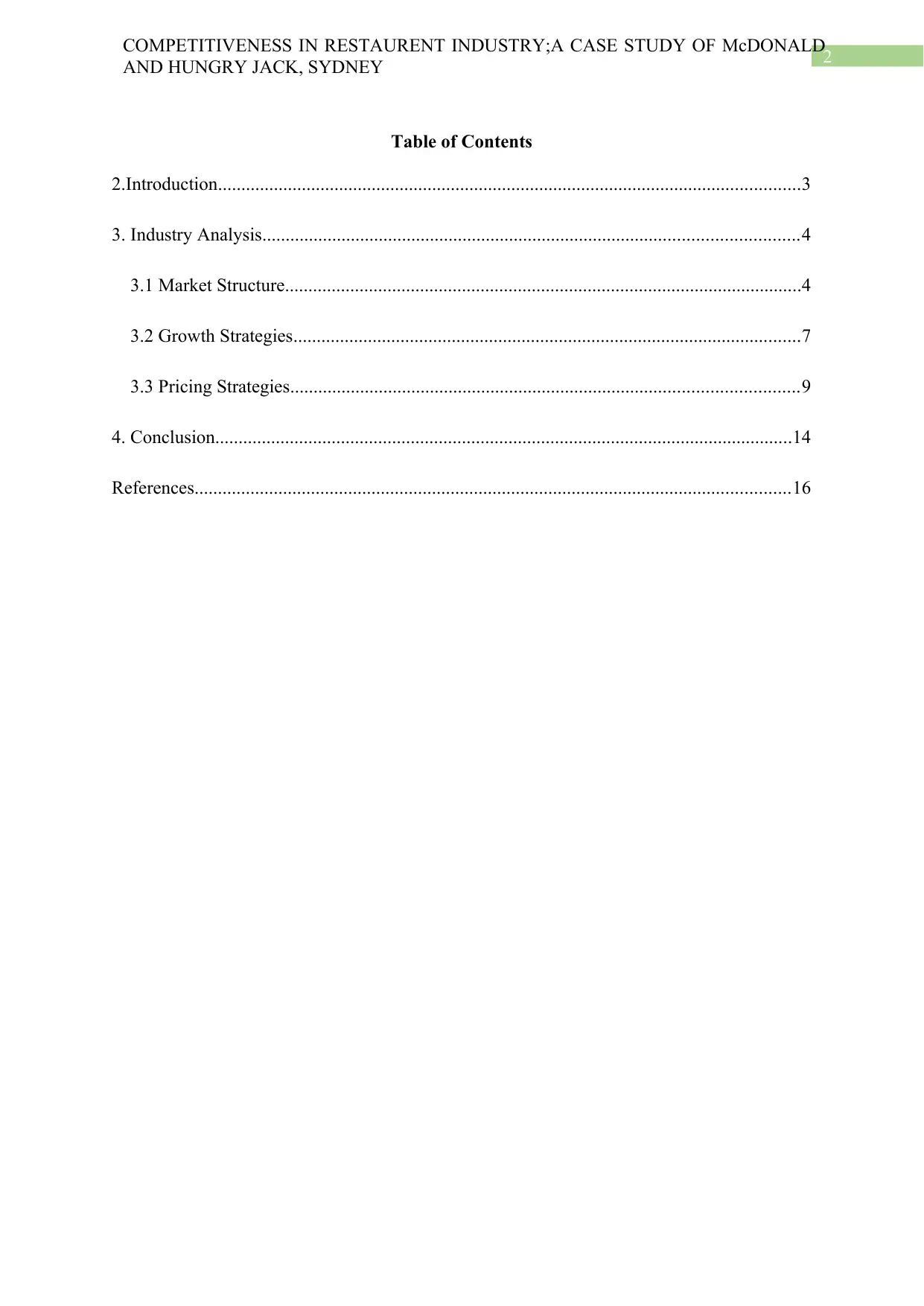
2
COMPETITIVENESS IN RESTAURENT INDUSTRY;A CASE STUDY OF McDONALD
AND HUNGRY JACK, SYDNEY
Table of Contents
2.Introduction.............................................................................................................................3
3. Industry Analysis...................................................................................................................4
3.1 Market Structure...............................................................................................................4
3.2 Growth Strategies.............................................................................................................7
3.3 Pricing Strategies.............................................................................................................9
4. Conclusion............................................................................................................................14
References................................................................................................................................16
COMPETITIVENESS IN RESTAURENT INDUSTRY;A CASE STUDY OF McDONALD
AND HUNGRY JACK, SYDNEY
Table of Contents
2.Introduction.............................................................................................................................3
3. Industry Analysis...................................................................................................................4
3.1 Market Structure...............................................................................................................4
3.2 Growth Strategies.............................................................................................................7
3.3 Pricing Strategies.............................................................................................................9
4. Conclusion............................................................................................................................14
References................................................................................................................................16
⊘ This is a preview!⊘
Do you want full access?
Subscribe today to unlock all pages.

Trusted by 1+ million students worldwide
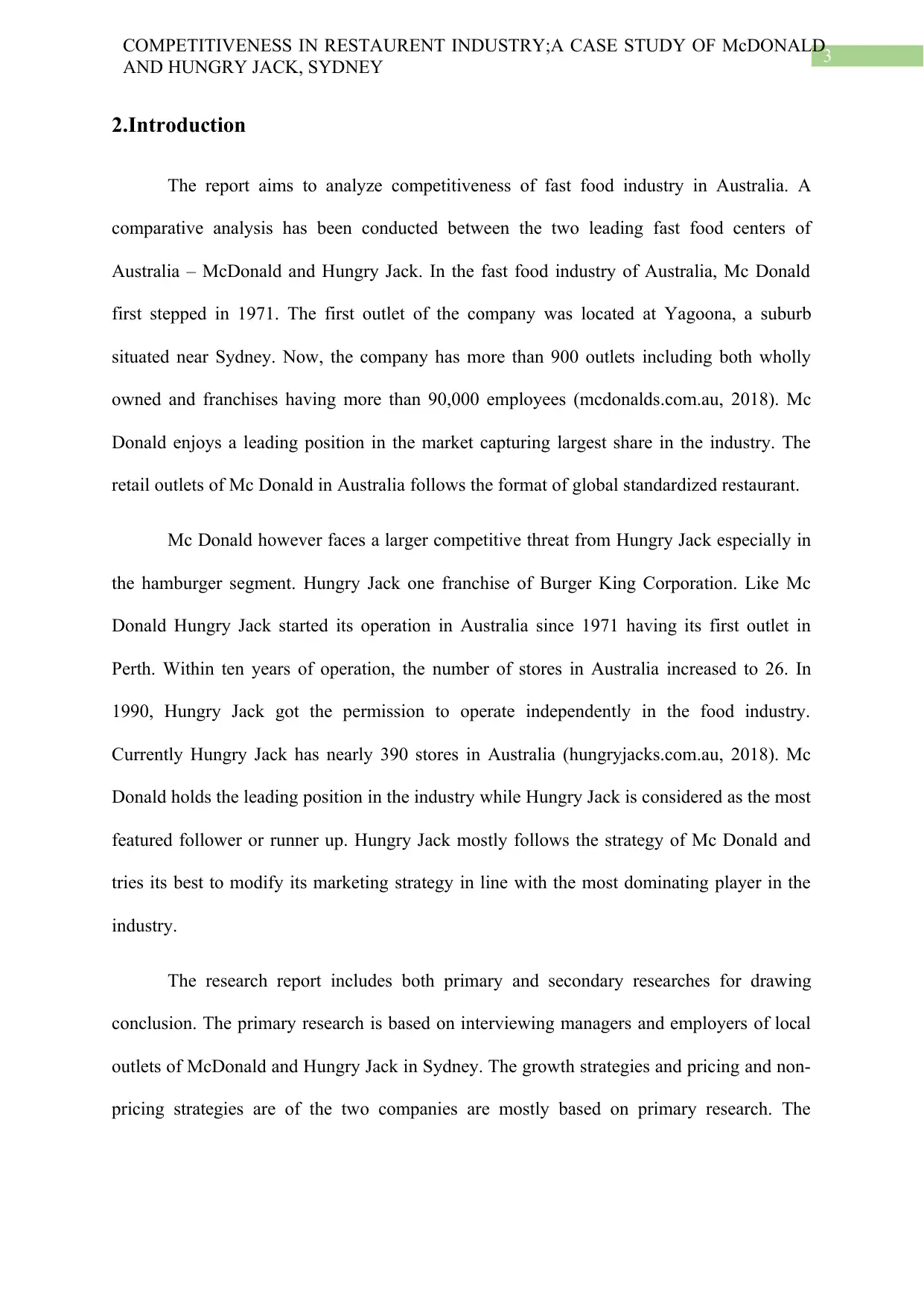
3
COMPETITIVENESS IN RESTAURENT INDUSTRY;A CASE STUDY OF McDONALD
AND HUNGRY JACK, SYDNEY
2.Introduction
The report aims to analyze competitiveness of fast food industry in Australia. A
comparative analysis has been conducted between the two leading fast food centers of
Australia – McDonald and Hungry Jack. In the fast food industry of Australia, Mc Donald
first stepped in 1971. The first outlet of the company was located at Yagoona, a suburb
situated near Sydney. Now, the company has more than 900 outlets including both wholly
owned and franchises having more than 90,000 employees (mcdonalds.com.au, 2018). Mc
Donald enjoys a leading position in the market capturing largest share in the industry. The
retail outlets of Mc Donald in Australia follows the format of global standardized restaurant.
Mc Donald however faces a larger competitive threat from Hungry Jack especially in
the hamburger segment. Hungry Jack one franchise of Burger King Corporation. Like Mc
Donald Hungry Jack started its operation in Australia since 1971 having its first outlet in
Perth. Within ten years of operation, the number of stores in Australia increased to 26. In
1990, Hungry Jack got the permission to operate independently in the food industry.
Currently Hungry Jack has nearly 390 stores in Australia (hungryjacks.com.au, 2018). Mc
Donald holds the leading position in the industry while Hungry Jack is considered as the most
featured follower or runner up. Hungry Jack mostly follows the strategy of Mc Donald and
tries its best to modify its marketing strategy in line with the most dominating player in the
industry.
The research report includes both primary and secondary researches for drawing
conclusion. The primary research is based on interviewing managers and employers of local
outlets of McDonald and Hungry Jack in Sydney. The growth strategies and pricing and non-
pricing strategies are of the two companies are mostly based on primary research. The
COMPETITIVENESS IN RESTAURENT INDUSTRY;A CASE STUDY OF McDONALD
AND HUNGRY JACK, SYDNEY
2.Introduction
The report aims to analyze competitiveness of fast food industry in Australia. A
comparative analysis has been conducted between the two leading fast food centers of
Australia – McDonald and Hungry Jack. In the fast food industry of Australia, Mc Donald
first stepped in 1971. The first outlet of the company was located at Yagoona, a suburb
situated near Sydney. Now, the company has more than 900 outlets including both wholly
owned and franchises having more than 90,000 employees (mcdonalds.com.au, 2018). Mc
Donald enjoys a leading position in the market capturing largest share in the industry. The
retail outlets of Mc Donald in Australia follows the format of global standardized restaurant.
Mc Donald however faces a larger competitive threat from Hungry Jack especially in
the hamburger segment. Hungry Jack one franchise of Burger King Corporation. Like Mc
Donald Hungry Jack started its operation in Australia since 1971 having its first outlet in
Perth. Within ten years of operation, the number of stores in Australia increased to 26. In
1990, Hungry Jack got the permission to operate independently in the food industry.
Currently Hungry Jack has nearly 390 stores in Australia (hungryjacks.com.au, 2018). Mc
Donald holds the leading position in the industry while Hungry Jack is considered as the most
featured follower or runner up. Hungry Jack mostly follows the strategy of Mc Donald and
tries its best to modify its marketing strategy in line with the most dominating player in the
industry.
The research report includes both primary and secondary researches for drawing
conclusion. The primary research is based on interviewing managers and employers of local
outlets of McDonald and Hungry Jack in Sydney. The growth strategies and pricing and non-
pricing strategies are of the two companies are mostly based on primary research. The
Paraphrase This Document
Need a fresh take? Get an instant paraphrase of this document with our AI Paraphraser
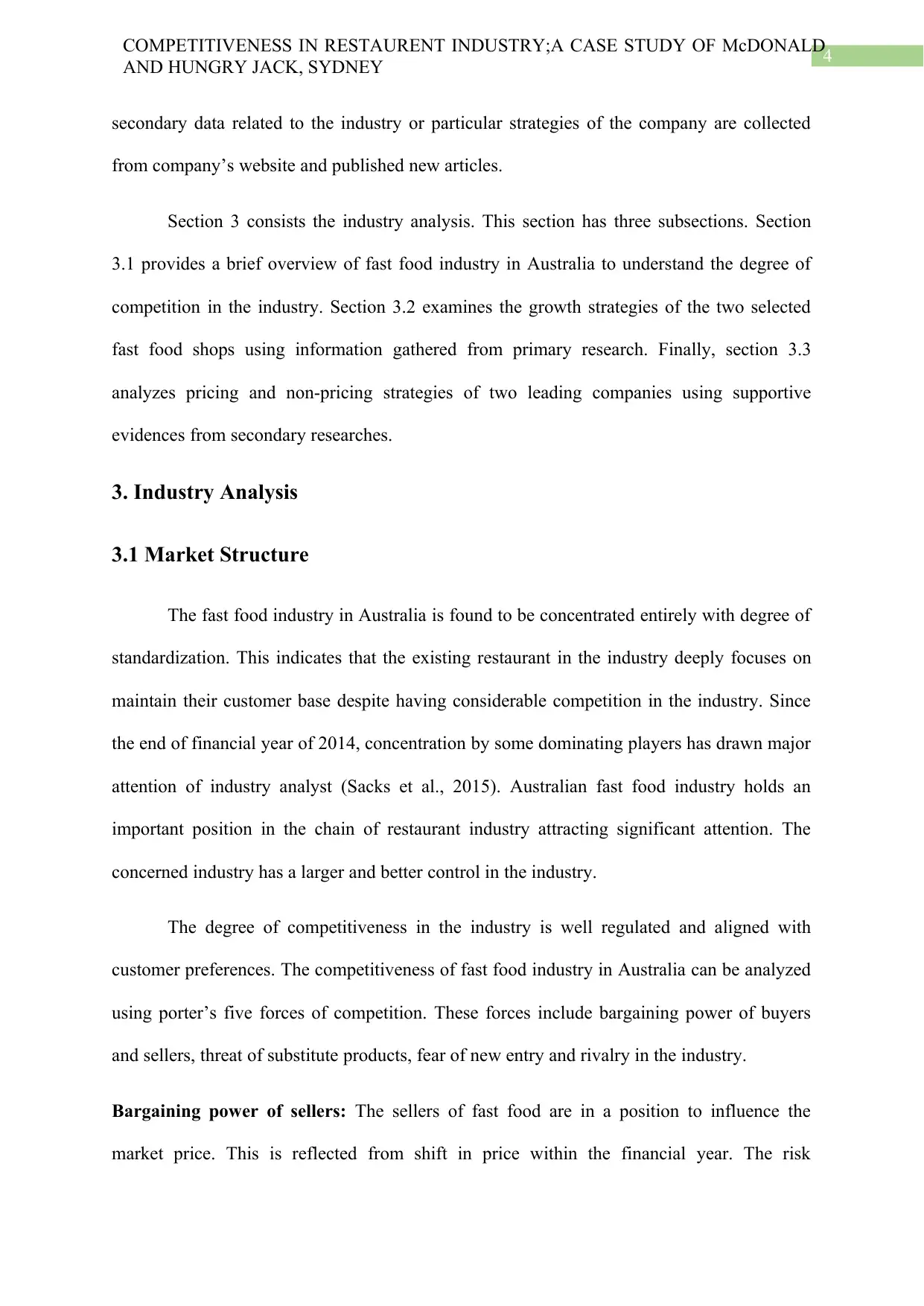
4
COMPETITIVENESS IN RESTAURENT INDUSTRY;A CASE STUDY OF McDONALD
AND HUNGRY JACK, SYDNEY
secondary data related to the industry or particular strategies of the company are collected
from company’s website and published new articles.
Section 3 consists the industry analysis. This section has three subsections. Section
3.1 provides a brief overview of fast food industry in Australia to understand the degree of
competition in the industry. Section 3.2 examines the growth strategies of the two selected
fast food shops using information gathered from primary research. Finally, section 3.3
analyzes pricing and non-pricing strategies of two leading companies using supportive
evidences from secondary researches.
3. Industry Analysis
3.1 Market Structure
The fast food industry in Australia is found to be concentrated entirely with degree of
standardization. This indicates that the existing restaurant in the industry deeply focuses on
maintain their customer base despite having considerable competition in the industry. Since
the end of financial year of 2014, concentration by some dominating players has drawn major
attention of industry analyst (Sacks et al., 2015). Australian fast food industry holds an
important position in the chain of restaurant industry attracting significant attention. The
concerned industry has a larger and better control in the industry.
The degree of competitiveness in the industry is well regulated and aligned with
customer preferences. The competitiveness of fast food industry in Australia can be analyzed
using porter’s five forces of competition. These forces include bargaining power of buyers
and sellers, threat of substitute products, fear of new entry and rivalry in the industry.
Bargaining power of sellers: The sellers of fast food are in a position to influence the
market price. This is reflected from shift in price within the financial year. The risk
COMPETITIVENESS IN RESTAURENT INDUSTRY;A CASE STUDY OF McDONALD
AND HUNGRY JACK, SYDNEY
secondary data related to the industry or particular strategies of the company are collected
from company’s website and published new articles.
Section 3 consists the industry analysis. This section has three subsections. Section
3.1 provides a brief overview of fast food industry in Australia to understand the degree of
competition in the industry. Section 3.2 examines the growth strategies of the two selected
fast food shops using information gathered from primary research. Finally, section 3.3
analyzes pricing and non-pricing strategies of two leading companies using supportive
evidences from secondary researches.
3. Industry Analysis
3.1 Market Structure
The fast food industry in Australia is found to be concentrated entirely with degree of
standardization. This indicates that the existing restaurant in the industry deeply focuses on
maintain their customer base despite having considerable competition in the industry. Since
the end of financial year of 2014, concentration by some dominating players has drawn major
attention of industry analyst (Sacks et al., 2015). Australian fast food industry holds an
important position in the chain of restaurant industry attracting significant attention. The
concerned industry has a larger and better control in the industry.
The degree of competitiveness in the industry is well regulated and aligned with
customer preferences. The competitiveness of fast food industry in Australia can be analyzed
using porter’s five forces of competition. These forces include bargaining power of buyers
and sellers, threat of substitute products, fear of new entry and rivalry in the industry.
Bargaining power of sellers: The sellers of fast food are in a position to influence the
market price. This is reflected from shift in price within the financial year. The risk
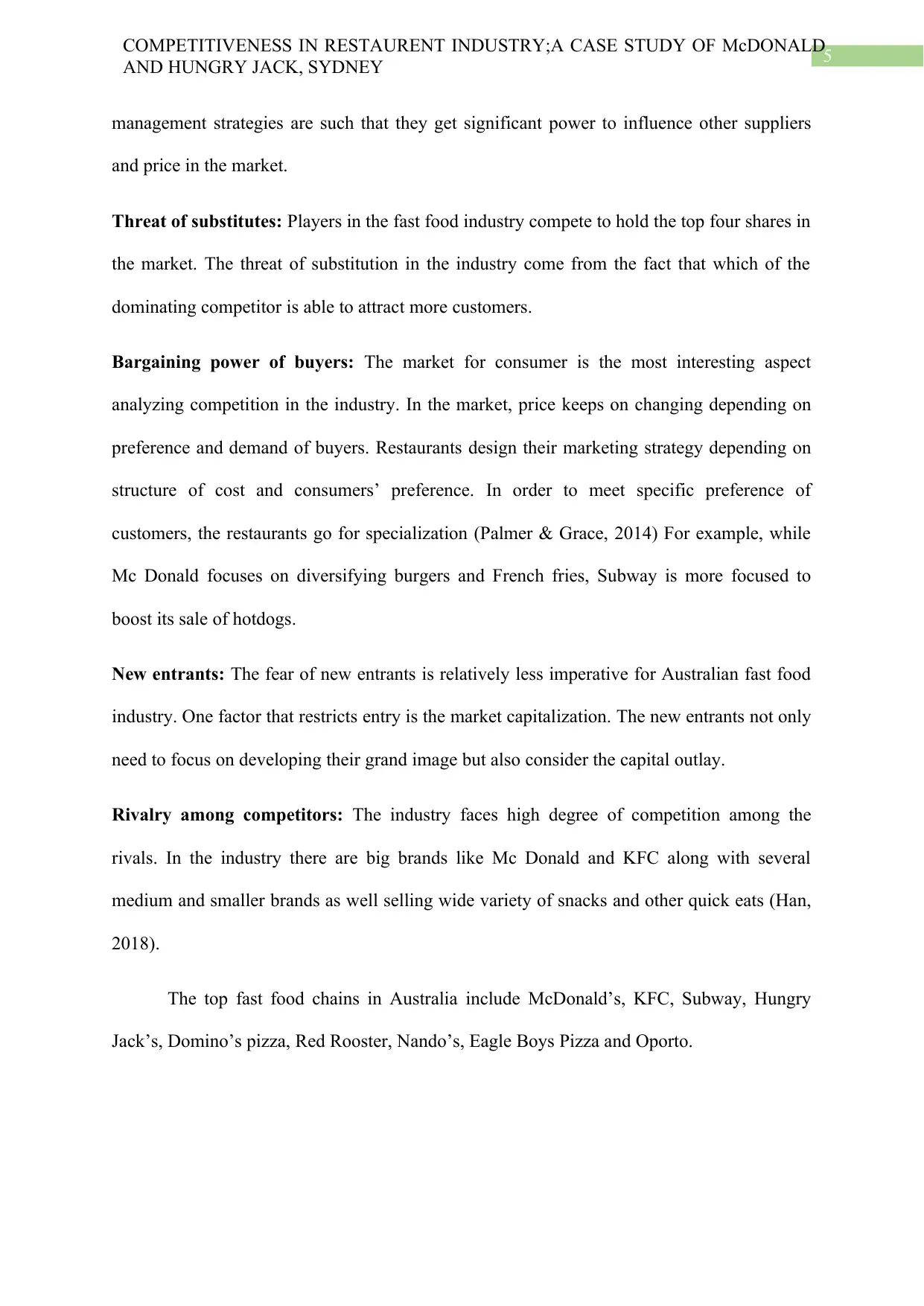
5
COMPETITIVENESS IN RESTAURENT INDUSTRY;A CASE STUDY OF McDONALD
AND HUNGRY JACK, SYDNEY
management strategies are such that they get significant power to influence other suppliers
and price in the market.
Threat of substitutes: Players in the fast food industry compete to hold the top four shares in
the market. The threat of substitution in the industry come from the fact that which of the
dominating competitor is able to attract more customers.
Bargaining power of buyers: The market for consumer is the most interesting aspect
analyzing competition in the industry. In the market, price keeps on changing depending on
preference and demand of buyers. Restaurants design their marketing strategy depending on
structure of cost and consumers’ preference. In order to meet specific preference of
customers, the restaurants go for specialization (Palmer & Grace, 2014) For example, while
Mc Donald focuses on diversifying burgers and French fries, Subway is more focused to
boost its sale of hotdogs.
New entrants: The fear of new entrants is relatively less imperative for Australian fast food
industry. One factor that restricts entry is the market capitalization. The new entrants not only
need to focus on developing their grand image but also consider the capital outlay.
Rivalry among competitors: The industry faces high degree of competition among the
rivals. In the industry there are big brands like Mc Donald and KFC along with several
medium and smaller brands as well selling wide variety of snacks and other quick eats (Han,
2018).
The top fast food chains in Australia include McDonald’s, KFC, Subway, Hungry
Jack’s, Domino’s pizza, Red Rooster, Nando’s, Eagle Boys Pizza and Oporto.
COMPETITIVENESS IN RESTAURENT INDUSTRY;A CASE STUDY OF McDONALD
AND HUNGRY JACK, SYDNEY
management strategies are such that they get significant power to influence other suppliers
and price in the market.
Threat of substitutes: Players in the fast food industry compete to hold the top four shares in
the market. The threat of substitution in the industry come from the fact that which of the
dominating competitor is able to attract more customers.
Bargaining power of buyers: The market for consumer is the most interesting aspect
analyzing competition in the industry. In the market, price keeps on changing depending on
preference and demand of buyers. Restaurants design their marketing strategy depending on
structure of cost and consumers’ preference. In order to meet specific preference of
customers, the restaurants go for specialization (Palmer & Grace, 2014) For example, while
Mc Donald focuses on diversifying burgers and French fries, Subway is more focused to
boost its sale of hotdogs.
New entrants: The fear of new entrants is relatively less imperative for Australian fast food
industry. One factor that restricts entry is the market capitalization. The new entrants not only
need to focus on developing their grand image but also consider the capital outlay.
Rivalry among competitors: The industry faces high degree of competition among the
rivals. In the industry there are big brands like Mc Donald and KFC along with several
medium and smaller brands as well selling wide variety of snacks and other quick eats (Han,
2018).
The top fast food chains in Australia include McDonald’s, KFC, Subway, Hungry
Jack’s, Domino’s pizza, Red Rooster, Nando’s, Eagle Boys Pizza and Oporto.
⊘ This is a preview!⊘
Do you want full access?
Subscribe today to unlock all pages.

Trusted by 1+ million students worldwide
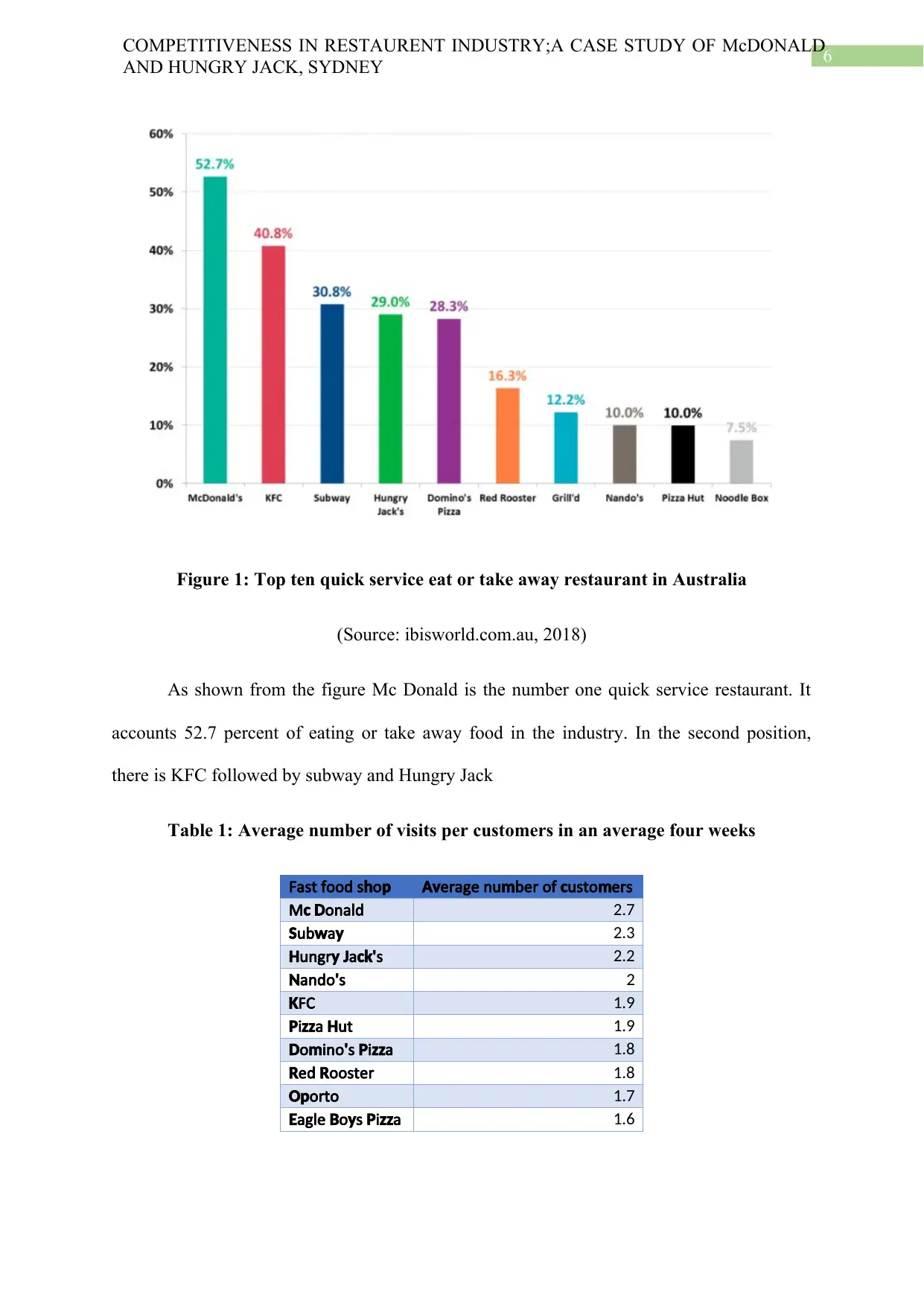
6
COMPETITIVENESS IN RESTAURENT INDUSTRY;A CASE STUDY OF McDONALD
AND HUNGRY JACK, SYDNEY
Figure 1: Top ten quick service eat or take away restaurant in Australia
(Source: ibisworld.com.au, 2018)
As shown from the figure Mc Donald is the number one quick service restaurant. It
accounts 52.7 percent of eating or take away food in the industry. In the second position,
there is KFC followed by subway and Hungry Jack
Table 1: Average number of visits per customers in an average four weeks
Fast food s oh p erage nu ber of usto ersAv m c m
M onaldc D 2.7
ub aS w y 2.3
ungr a sH y J ck' 2.2
ando sN ' 2
FCK 1.9
i a utP zz H 1.9
o ino s i aD m ' P zz 1.8
ed oosterR R 1.8
ortoOp 1.7
agle o s i aE B y P zz 1.6
COMPETITIVENESS IN RESTAURENT INDUSTRY;A CASE STUDY OF McDONALD
AND HUNGRY JACK, SYDNEY
Figure 1: Top ten quick service eat or take away restaurant in Australia
(Source: ibisworld.com.au, 2018)
As shown from the figure Mc Donald is the number one quick service restaurant. It
accounts 52.7 percent of eating or take away food in the industry. In the second position,
there is KFC followed by subway and Hungry Jack
Table 1: Average number of visits per customers in an average four weeks
Fast food s oh p erage nu ber of usto ersAv m c m
M onaldc D 2.7
ub aS w y 2.3
ungr a sH y J ck' 2.2
ando sN ' 2
FCK 1.9
i a utP zz H 1.9
o ino s i aD m ' P zz 1.8
ed oosterR R 1.8
ortoOp 1.7
agle o s i aE B y P zz 1.6
Paraphrase This Document
Need a fresh take? Get an instant paraphrase of this document with our AI Paraphraser
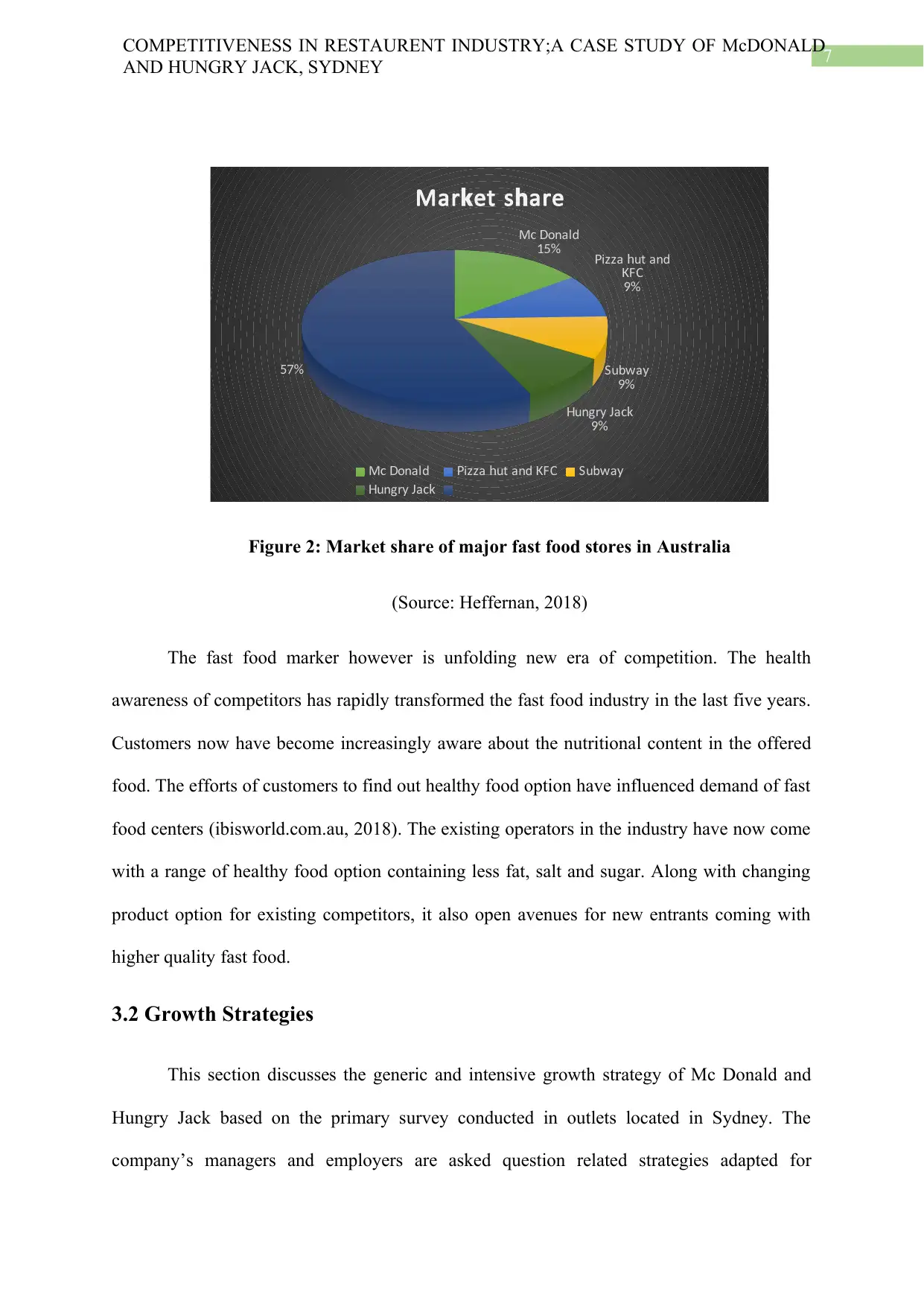
7
COMPETITIVENESS IN RESTAURENT INDUSTRY;A CASE STUDY OF McDONALD
AND HUNGRY JACK, SYDNEY
M onaldc D
15% i a ut andP zz h
FCK
9%
ub aS w y
9%
ungr aH y J ck
9%
57%
Mar et s arek h
M onaldc D i a ut and FCP zz h K ub aS w y
ungr aH y J ck
Figure 2: Market share of major fast food stores in Australia
(Source: Heffernan, 2018)
The fast food marker however is unfolding new era of competition. The health
awareness of competitors has rapidly transformed the fast food industry in the last five years.
Customers now have become increasingly aware about the nutritional content in the offered
food. The efforts of customers to find out healthy food option have influenced demand of fast
food centers (ibisworld.com.au, 2018). The existing operators in the industry have now come
with a range of healthy food option containing less fat, salt and sugar. Along with changing
product option for existing competitors, it also open avenues for new entrants coming with
higher quality fast food.
3.2 Growth Strategies
This section discusses the generic and intensive growth strategy of Mc Donald and
Hungry Jack based on the primary survey conducted in outlets located in Sydney. The
company’s managers and employers are asked question related strategies adapted for
COMPETITIVENESS IN RESTAURENT INDUSTRY;A CASE STUDY OF McDONALD
AND HUNGRY JACK, SYDNEY
M onaldc D
15% i a ut andP zz h
FCK
9%
ub aS w y
9%
ungr aH y J ck
9%
57%
Mar et s arek h
M onaldc D i a ut and FCP zz h K ub aS w y
ungr aH y J ck
Figure 2: Market share of major fast food stores in Australia
(Source: Heffernan, 2018)
The fast food marker however is unfolding new era of competition. The health
awareness of competitors has rapidly transformed the fast food industry in the last five years.
Customers now have become increasingly aware about the nutritional content in the offered
food. The efforts of customers to find out healthy food option have influenced demand of fast
food centers (ibisworld.com.au, 2018). The existing operators in the industry have now come
with a range of healthy food option containing less fat, salt and sugar. Along with changing
product option for existing competitors, it also open avenues for new entrants coming with
higher quality fast food.
3.2 Growth Strategies
This section discusses the generic and intensive growth strategy of Mc Donald and
Hungry Jack based on the primary survey conducted in outlets located in Sydney. The
company’s managers and employers are asked question related strategies adapted for
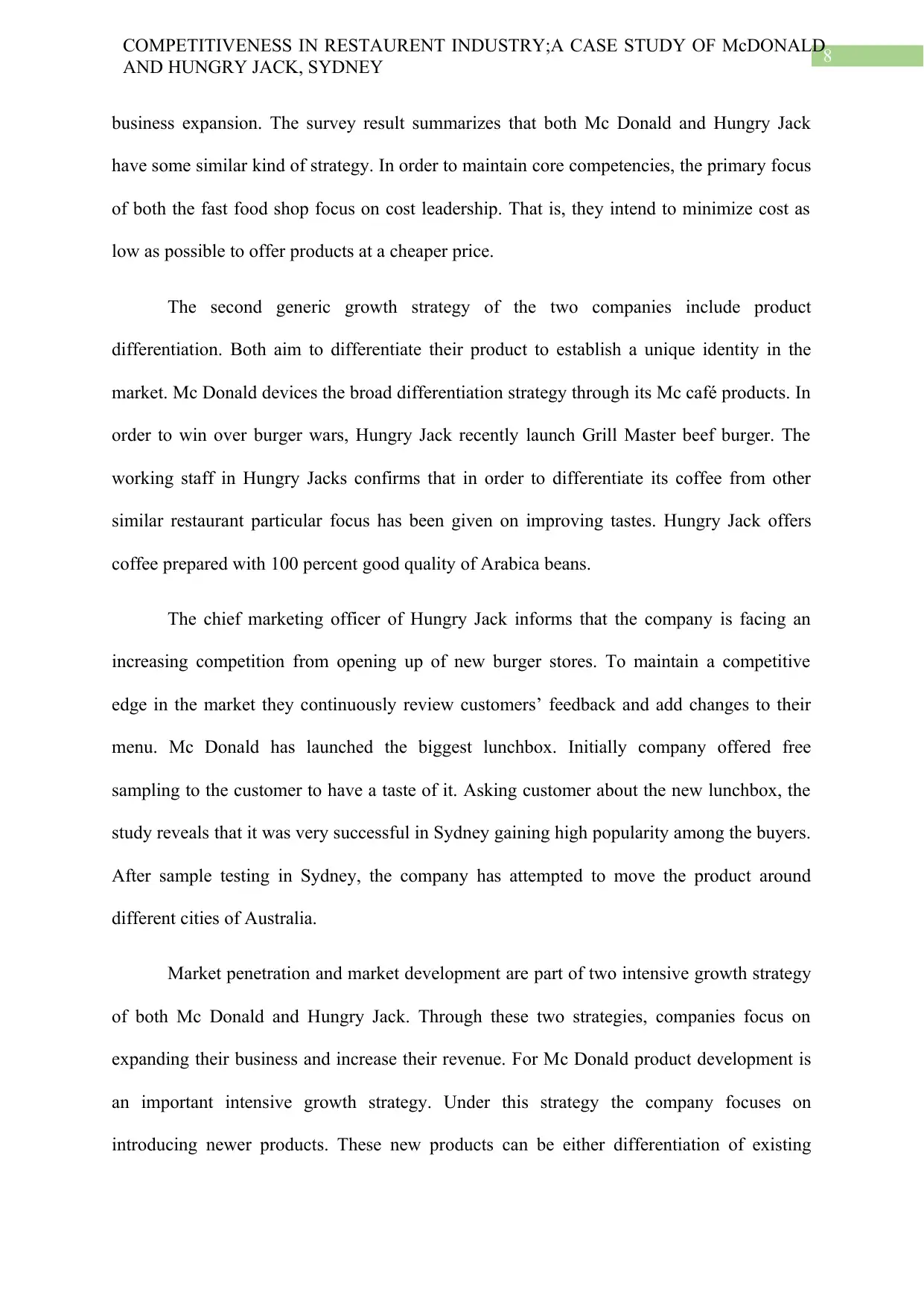
8
COMPETITIVENESS IN RESTAURENT INDUSTRY;A CASE STUDY OF McDONALD
AND HUNGRY JACK, SYDNEY
business expansion. The survey result summarizes that both Mc Donald and Hungry Jack
have some similar kind of strategy. In order to maintain core competencies, the primary focus
of both the fast food shop focus on cost leadership. That is, they intend to minimize cost as
low as possible to offer products at a cheaper price.
The second generic growth strategy of the two companies include product
differentiation. Both aim to differentiate their product to establish a unique identity in the
market. Mc Donald devices the broad differentiation strategy through its Mc café products. In
order to win over burger wars, Hungry Jack recently launch Grill Master beef burger. The
working staff in Hungry Jacks confirms that in order to differentiate its coffee from other
similar restaurant particular focus has been given on improving tastes. Hungry Jack offers
coffee prepared with 100 percent good quality of Arabica beans.
The chief marketing officer of Hungry Jack informs that the company is facing an
increasing competition from opening up of new burger stores. To maintain a competitive
edge in the market they continuously review customers’ feedback and add changes to their
menu. Mc Donald has launched the biggest lunchbox. Initially company offered free
sampling to the customer to have a taste of it. Asking customer about the new lunchbox, the
study reveals that it was very successful in Sydney gaining high popularity among the buyers.
After sample testing in Sydney, the company has attempted to move the product around
different cities of Australia.
Market penetration and market development are part of two intensive growth strategy
of both Mc Donald and Hungry Jack. Through these two strategies, companies focus on
expanding their business and increase their revenue. For Mc Donald product development is
an important intensive growth strategy. Under this strategy the company focuses on
introducing newer products. These new products can be either differentiation of existing
COMPETITIVENESS IN RESTAURENT INDUSTRY;A CASE STUDY OF McDONALD
AND HUNGRY JACK, SYDNEY
business expansion. The survey result summarizes that both Mc Donald and Hungry Jack
have some similar kind of strategy. In order to maintain core competencies, the primary focus
of both the fast food shop focus on cost leadership. That is, they intend to minimize cost as
low as possible to offer products at a cheaper price.
The second generic growth strategy of the two companies include product
differentiation. Both aim to differentiate their product to establish a unique identity in the
market. Mc Donald devices the broad differentiation strategy through its Mc café products. In
order to win over burger wars, Hungry Jack recently launch Grill Master beef burger. The
working staff in Hungry Jacks confirms that in order to differentiate its coffee from other
similar restaurant particular focus has been given on improving tastes. Hungry Jack offers
coffee prepared with 100 percent good quality of Arabica beans.
The chief marketing officer of Hungry Jack informs that the company is facing an
increasing competition from opening up of new burger stores. To maintain a competitive
edge in the market they continuously review customers’ feedback and add changes to their
menu. Mc Donald has launched the biggest lunchbox. Initially company offered free
sampling to the customer to have a taste of it. Asking customer about the new lunchbox, the
study reveals that it was very successful in Sydney gaining high popularity among the buyers.
After sample testing in Sydney, the company has attempted to move the product around
different cities of Australia.
Market penetration and market development are part of two intensive growth strategy
of both Mc Donald and Hungry Jack. Through these two strategies, companies focus on
expanding their business and increase their revenue. For Mc Donald product development is
an important intensive growth strategy. Under this strategy the company focuses on
introducing newer products. These new products can be either differentiation of existing
⊘ This is a preview!⊘
Do you want full access?
Subscribe today to unlock all pages.

Trusted by 1+ million students worldwide
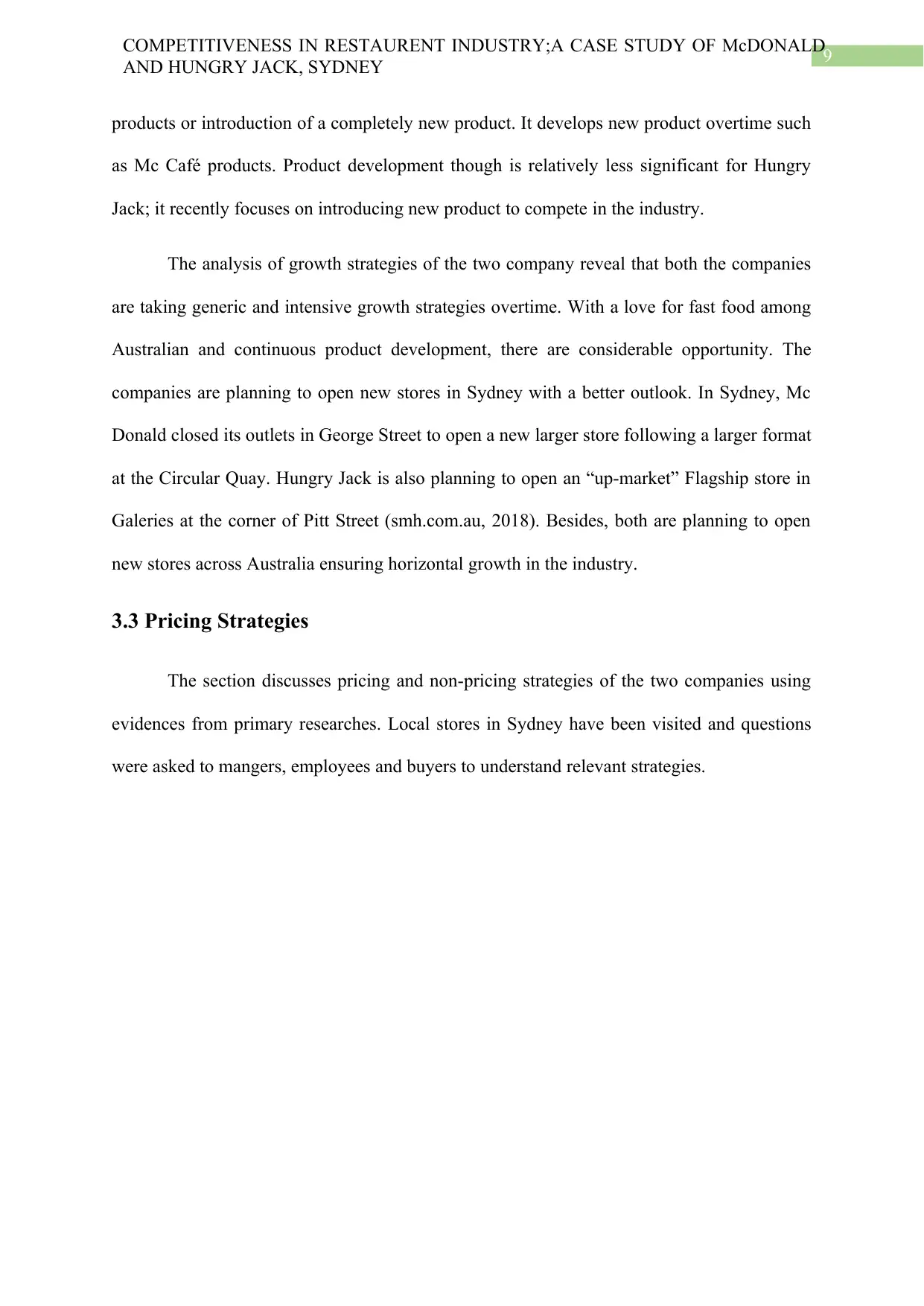
9
COMPETITIVENESS IN RESTAURENT INDUSTRY;A CASE STUDY OF McDONALD
AND HUNGRY JACK, SYDNEY
products or introduction of a completely new product. It develops new product overtime such
as Mc Café products. Product development though is relatively less significant for Hungry
Jack; it recently focuses on introducing new product to compete in the industry.
The analysis of growth strategies of the two company reveal that both the companies
are taking generic and intensive growth strategies overtime. With a love for fast food among
Australian and continuous product development, there are considerable opportunity. The
companies are planning to open new stores in Sydney with a better outlook. In Sydney, Mc
Donald closed its outlets in George Street to open a new larger store following a larger format
at the Circular Quay. Hungry Jack is also planning to open an “up-market” Flagship store in
Galeries at the corner of Pitt Street (smh.com.au, 2018). Besides, both are planning to open
new stores across Australia ensuring horizontal growth in the industry.
3.3 Pricing Strategies
The section discusses pricing and non-pricing strategies of the two companies using
evidences from primary researches. Local stores in Sydney have been visited and questions
were asked to mangers, employees and buyers to understand relevant strategies.
COMPETITIVENESS IN RESTAURENT INDUSTRY;A CASE STUDY OF McDONALD
AND HUNGRY JACK, SYDNEY
products or introduction of a completely new product. It develops new product overtime such
as Mc Café products. Product development though is relatively less significant for Hungry
Jack; it recently focuses on introducing new product to compete in the industry.
The analysis of growth strategies of the two company reveal that both the companies
are taking generic and intensive growth strategies overtime. With a love for fast food among
Australian and continuous product development, there are considerable opportunity. The
companies are planning to open new stores in Sydney with a better outlook. In Sydney, Mc
Donald closed its outlets in George Street to open a new larger store following a larger format
at the Circular Quay. Hungry Jack is also planning to open an “up-market” Flagship store in
Galeries at the corner of Pitt Street (smh.com.au, 2018). Besides, both are planning to open
new stores across Australia ensuring horizontal growth in the industry.
3.3 Pricing Strategies
The section discusses pricing and non-pricing strategies of the two companies using
evidences from primary researches. Local stores in Sydney have been visited and questions
were asked to mangers, employees and buyers to understand relevant strategies.
Paraphrase This Document
Need a fresh take? Get an instant paraphrase of this document with our AI Paraphraser
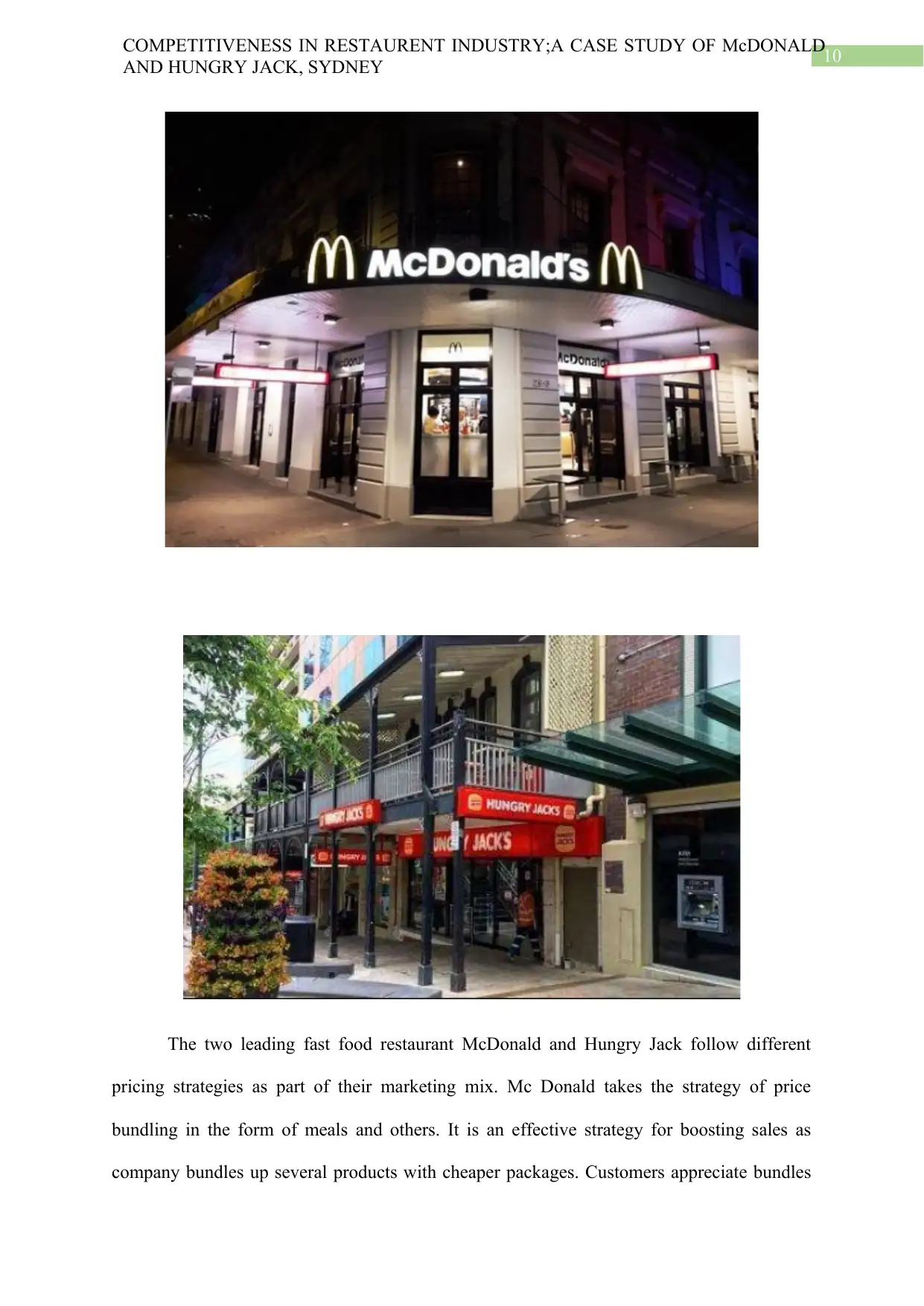
10
COMPETITIVENESS IN RESTAURENT INDUSTRY;A CASE STUDY OF McDONALD
AND HUNGRY JACK, SYDNEY
The two leading fast food restaurant McDonald and Hungry Jack follow different
pricing strategies as part of their marketing mix. Mc Donald takes the strategy of price
bundling in the form of meals and others. It is an effective strategy for boosting sales as
company bundles up several products with cheaper packages. Customers appreciate bundles
COMPETITIVENESS IN RESTAURENT INDUSTRY;A CASE STUDY OF McDONALD
AND HUNGRY JACK, SYDNEY
The two leading fast food restaurant McDonald and Hungry Jack follow different
pricing strategies as part of their marketing mix. Mc Donald takes the strategy of price
bundling in the form of meals and others. It is an effective strategy for boosting sales as
company bundles up several products with cheaper packages. Customers appreciate bundles
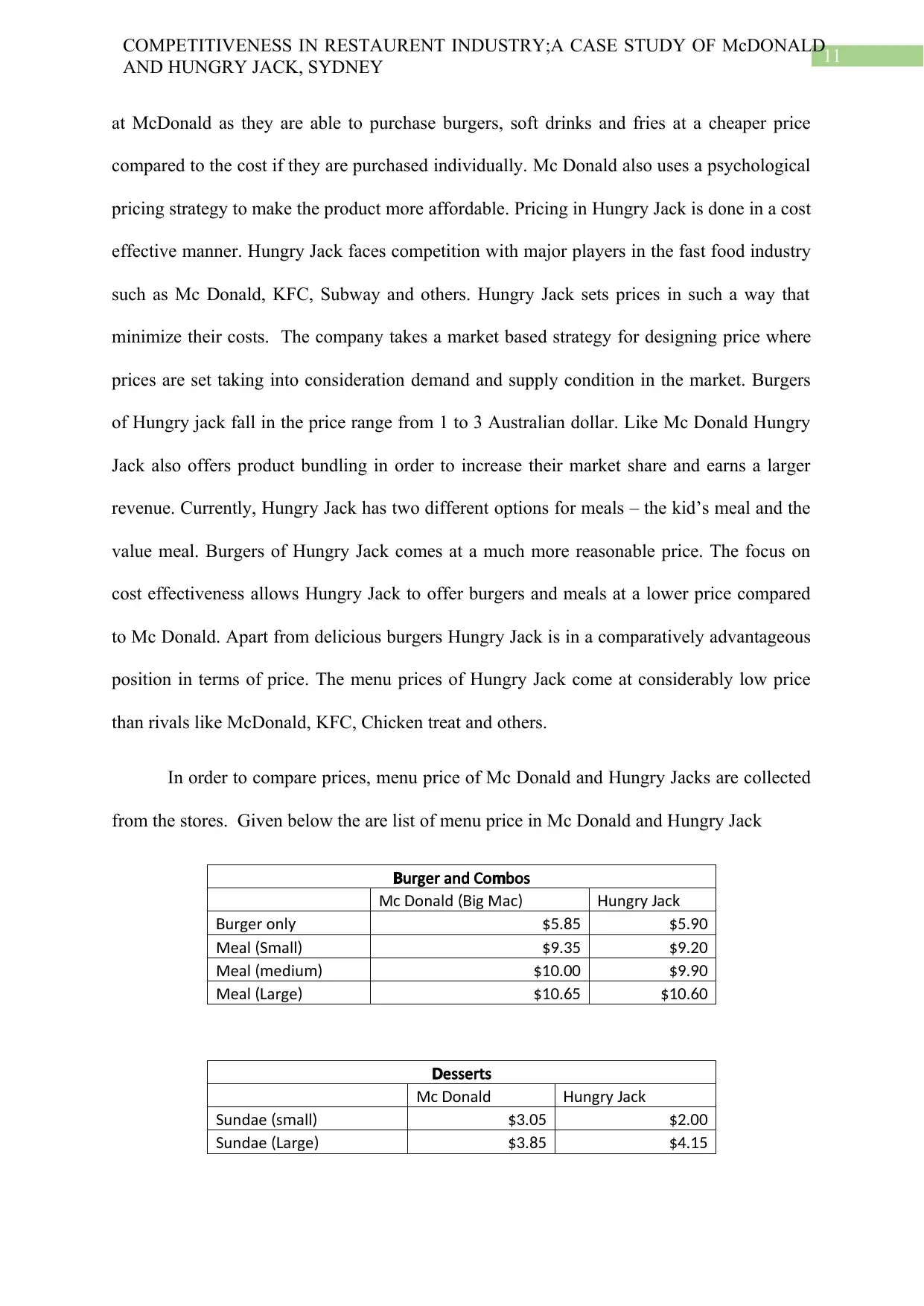
11
COMPETITIVENESS IN RESTAURENT INDUSTRY;A CASE STUDY OF McDONALD
AND HUNGRY JACK, SYDNEY
at McDonald as they are able to purchase burgers, soft drinks and fries at a cheaper price
compared to the cost if they are purchased individually. Mc Donald also uses a psychological
pricing strategy to make the product more affordable. Pricing in Hungry Jack is done in a cost
effective manner. Hungry Jack faces competition with major players in the fast food industry
such as Mc Donald, KFC, Subway and others. Hungry Jack sets prices in such a way that
minimize their costs. The company takes a market based strategy for designing price where
prices are set taking into consideration demand and supply condition in the market. Burgers
of Hungry jack fall in the price range from 1 to 3 Australian dollar. Like Mc Donald Hungry
Jack also offers product bundling in order to increase their market share and earns a larger
revenue. Currently, Hungry Jack has two different options for meals – the kid’s meal and the
value meal. Burgers of Hungry Jack comes at a much more reasonable price. The focus on
cost effectiveness allows Hungry Jack to offer burgers and meals at a lower price compared
to Mc Donald. Apart from delicious burgers Hungry Jack is in a comparatively advantageous
position in terms of price. The menu prices of Hungry Jack come at considerably low price
than rivals like McDonald, KFC, Chicken treat and others.
In order to compare prices, menu price of Mc Donald and Hungry Jacks are collected
from the stores. Given below the are list of menu price in Mc Donald and Hungry Jack
urger and Co bosB m
M onald ig Mac D (B c) ungr aH y J ck
urger onlB y $5.85 $5.90
Meal all(Sm ) $9.35 $9.20
Meal ediu(m m) $10.00 $9.90
Meal arge(L ) $10.65 $10.60
essertsD
M onaldc D ungr aH y J ck
undae s allS ( m ) $3.05 $2.00
undae argeS (L ) $3.85 $4.15
COMPETITIVENESS IN RESTAURENT INDUSTRY;A CASE STUDY OF McDONALD
AND HUNGRY JACK, SYDNEY
at McDonald as they are able to purchase burgers, soft drinks and fries at a cheaper price
compared to the cost if they are purchased individually. Mc Donald also uses a psychological
pricing strategy to make the product more affordable. Pricing in Hungry Jack is done in a cost
effective manner. Hungry Jack faces competition with major players in the fast food industry
such as Mc Donald, KFC, Subway and others. Hungry Jack sets prices in such a way that
minimize their costs. The company takes a market based strategy for designing price where
prices are set taking into consideration demand and supply condition in the market. Burgers
of Hungry jack fall in the price range from 1 to 3 Australian dollar. Like Mc Donald Hungry
Jack also offers product bundling in order to increase their market share and earns a larger
revenue. Currently, Hungry Jack has two different options for meals – the kid’s meal and the
value meal. Burgers of Hungry Jack comes at a much more reasonable price. The focus on
cost effectiveness allows Hungry Jack to offer burgers and meals at a lower price compared
to Mc Donald. Apart from delicious burgers Hungry Jack is in a comparatively advantageous
position in terms of price. The menu prices of Hungry Jack come at considerably low price
than rivals like McDonald, KFC, Chicken treat and others.
In order to compare prices, menu price of Mc Donald and Hungry Jacks are collected
from the stores. Given below the are list of menu price in Mc Donald and Hungry Jack
urger and Co bosB m
M onald ig Mac D (B c) ungr aH y J ck
urger onlB y $5.85 $5.90
Meal all(Sm ) $9.35 $9.20
Meal ediu(m m) $10.00 $9.90
Meal arge(L ) $10.65 $10.60
essertsD
M onaldc D ungr aH y J ck
undae s allS ( m ) $3.05 $2.00
undae argeS (L ) $3.85 $4.15
⊘ This is a preview!⊘
Do you want full access?
Subscribe today to unlock all pages.

Trusted by 1+ million students worldwide
1 out of 18
Related Documents
Your All-in-One AI-Powered Toolkit for Academic Success.
+13062052269
info@desklib.com
Available 24*7 on WhatsApp / Email
![[object Object]](/_next/static/media/star-bottom.7253800d.svg)
Unlock your academic potential
Copyright © 2020–2025 A2Z Services. All Rights Reserved. Developed and managed by ZUCOL.



